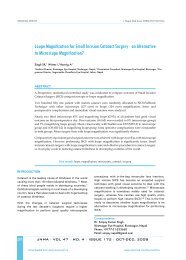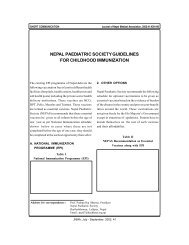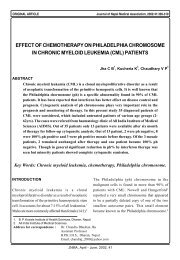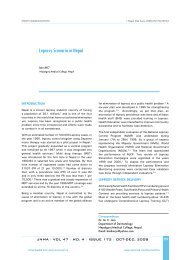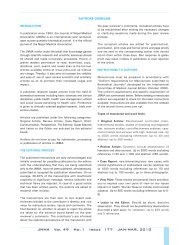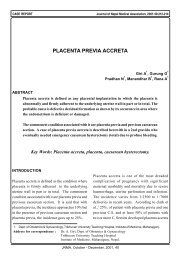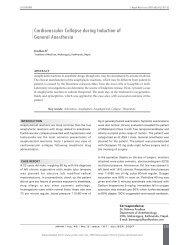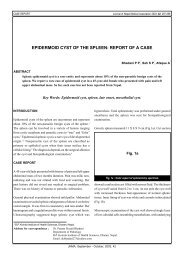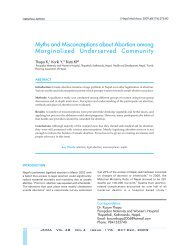Organophosphorus Poisoning - Journal of Nepal Medical Association
Organophosphorus Poisoning - Journal of Nepal Medical Association
Organophosphorus Poisoning - Journal of Nepal Medical Association
You also want an ePaper? Increase the reach of your titles
YUMPU automatically turns print PDFs into web optimized ePapers that Google loves.
REVIEW ARTICLE J <strong>Nepal</strong> Med Assoc 2008;47(172):251-8<br />
<strong>Organophosphorus</strong> <strong>Poisoning</strong><br />
Paudyal BP 1<br />
1<br />
Department <strong>of</strong> Medicine, Patan Hospital, Lalitpur<br />
Abstract<br />
Acute poisoning by organophosphorus (OP) compounds is a major global clinical problem, with<br />
thousands <strong>of</strong> deaths occurring every year. Most <strong>of</strong> these pesticide poisoning and subsequent<br />
deaths occur in developing countries following a deliberate self ingestion <strong>of</strong> the poison. Metacid<br />
(Methyl parathion) and Nuvan (Dichlorovos) are commonly ingested OP pesticides; Dimethoate,<br />
Pr<strong>of</strong>en<strong>of</strong>os, and Chlorpyrifos are other less frequently ingested compounds in <strong>Nepal</strong>. The toxicity<br />
<strong>of</strong> these OP pesticides is due to the irreversible inhibition <strong>of</strong> acetylcholinesterase (AChE) enzyme<br />
leading to accumulation <strong>of</strong> acetylcholine and subsequent over-activation <strong>of</strong> cholinergic receptors<br />
in various parts <strong>of</strong> the body. Acutely, these patients present with cholinergic crisis; intermediate<br />
syndrome and delayed polyneuropathy are other sequel <strong>of</strong> this form <strong>of</strong> poisoning. The diagnosis<br />
depends on the history <strong>of</strong> exposure to these pesticides, characteristic manifestations <strong>of</strong> toxicity<br />
and improvements <strong>of</strong> the signs and symptoms after administration <strong>of</strong> atropine. The supportive<br />
treatment <strong>of</strong> OP poisoning includes the same basic principles <strong>of</strong> management <strong>of</strong> any acutely<br />
poisoned patient i.e., rapid initial management <strong>of</strong> airways, breathing, and circulation. Gastric<br />
lavage and activated charcoal are routinely used decontamination procedures, but their value<br />
has not been conclusively proven in this poisoning. Atropine is the mainstay <strong>of</strong> therapy, and<br />
can reverse the life threatening features <strong>of</strong> this acute poisoning. However, there are no clear<br />
cut guidelines on the dose and duration <strong>of</strong> atropine therapy in OP poisoning. Cholinesterase<br />
reactivators, by regenerating AChE, can reverse both the nicotinic and muscarinic effects;<br />
however, this benefit has not been translated well in clinical trials. All these facts highlight that<br />
there are many unanswered questions and controversies in the management <strong>of</strong> OP poisoning<br />
and there is an urgent need for research on this aspect <strong>of</strong> this common and deadly poisoning.<br />
Key Words: poisoning, organophosphorus insecticides, decontamination, antidotes<br />
INTRODUCTION<br />
<strong>Organophosphorus</strong> (OP) compounds are used as<br />
pesticides, herbicides, and chemical warfare agents<br />
in the form <strong>of</strong> nerve gases. 1 Acute poisoning by<br />
these agents is a major global clinical problem, with<br />
thousands <strong>of</strong> deaths occurring every year. 2 Most <strong>of</strong> the<br />
OP pesticide poisoning and subsequent deaths occur<br />
in developing countries following a deliberate self<br />
ingestion particularly in young, productive age group,<br />
as highly toxic pesticides are readily available at the<br />
moments <strong>of</strong> stress. 3<br />
Correspondence:<br />
Dr. Buddhi P Paudyal<br />
Department <strong>of</strong> Medicine<br />
Patan Hospital, Lalitpur.<br />
Email: buddhipaudyal@yahoo.com<br />
JNMA I VOL 47 I NO. 4 I ISSUE 172 I OCT-DEC, 2008 251<br />
Downloaded from www.jnma.com.np<br />
www.xenomed.com/forums/jnma
Paudyal. <strong>Organophosphorus</strong> <strong>Poisoning</strong><br />
<strong>Poisoning</strong> has been a common cause <strong>of</strong> medical<br />
admissions and deaths in <strong>Nepal</strong>ese hospitals. 4-11 Thirtyone<br />
percent <strong>of</strong> all suicidal deaths in the country in 1999-<br />
2000 were due to poisoning. 12 Hospital- based studies<br />
from five major hospitals across the country in 1999-<br />
2000 showed OP compounds were the most common<br />
form <strong>of</strong> poisoning comprising 52% <strong>of</strong> total cases. 13<br />
Various isolated hospital-based studies also clearly<br />
demonstrate that OP compounds occupy the greatest<br />
burden <strong>of</strong> poisoning related morbidity and mortality in<br />
<strong>Nepal</strong>. 4<br />
Compounds<br />
<strong>Organophosphorus</strong> compounds were first developed by<br />
Schrader shortly before and during the Second World<br />
War. They were first used as an agricultural insecticide<br />
and later as potential chemical warfare agents. 14 These<br />
compounds are normally esters, thiol esters, or acid<br />
anhydride derivatives <strong>of</strong> phosphorus containing acids.<br />
Of the more than 100 OP pesticides used worldwide,<br />
the majority are either dimethyl phosphoryl or diethyl<br />
phosphoryl compounds. 15 Nerve gas compounds like<br />
tabun, sarin, and soman are highly potent synthetic<br />
toxic agents <strong>of</strong> this group. Commonly available dimethyl<br />
and diethyl OP compounds are listed in Table 1. Table<br />
2 presents the commonly available OP pesticides with<br />
their brand names in <strong>Nepal</strong>ese market.<br />
Table 1. Common dimethyl and diethyl phosphoryl<br />
compounds 17<br />
Dimethyl Ops<br />
Parathion<br />
Diazinon<br />
Chlorpyrifos<br />
Dichlorfenthion<br />
Coumaphos<br />
Diethyl OPs<br />
Methyl parathion<br />
Dichlorovos<br />
Dimethoate<br />
Malathion<br />
Fenthion<br />
Table 2. Common OP pesticides with their brands<br />
available in <strong>Nepal</strong><br />
OP pesticide<br />
Methyl parathion<br />
Dichlorovos<br />
Dimethoate<br />
Chlorpyrifos<br />
Fenthion<br />
Pr<strong>of</strong>en<strong>of</strong>os<br />
Quinalphos<br />
Monocrotophos<br />
Brands available<br />
Metacid, Parahit, Paradol<br />
Nuvan, DDVP, Nudan, Suchlor<br />
Rogor, Roger, Rogohit<br />
Durmet, Dhanuban, Radar<br />
Dalf, Baytex<br />
Current<br />
Krush<br />
Phoskill<br />
Hospital-based data from across the country show<br />
that Methyl-parathion, Dichlorovos, Dimethoate,<br />
Chlorpyrifos and Malathion are the common OPs related<br />
with human poisoning. ‘Metacid’, a popular brand for<br />
Methyl parathion is the most frequently ingested and<br />
probably the most toxic organophosphate used for<br />
poisoning in <strong>Nepal</strong>. Dichlorovos, or ‘Nuvan’ as it is<br />
commonly known, is moderately volatile solution; its<br />
use has been on rise for self harm in recent years. 4<br />
Dimethoate has a lethal dose <strong>of</strong> 10-12 gm and there<br />
are concerns that it causes specific cardiac toxicities in<br />
addition to cholinergic syndrome. Malathion is relatively<br />
less-toxic and is used for the treatment <strong>of</strong> pediculosis<br />
and scabies in humans; and has a lethal dose is 1 gm/kg<br />
in mammals. 16<br />
Mechanism <strong>of</strong> toxicity<br />
The toxic mechanism <strong>of</strong> OP compounds is based on<br />
the irreversible inhibition <strong>of</strong> acetylcholinesterase due<br />
to phosphorylation <strong>of</strong> the active site <strong>of</strong> the enzyme.<br />
This leads to accumulation <strong>of</strong> acetylcholine and<br />
subsequent over-activation <strong>of</strong> cholinergic receptors<br />
at the neuromuscular junctions and in the autonomic<br />
and central nervous systems. The rate and degree <strong>of</strong><br />
AChE inhibition differs according to the structure <strong>of</strong><br />
the OP compounds and the nature <strong>of</strong> their metabolite.<br />
In general, pure thion compounds are not significant<br />
inhibitors in their original form and need metabolic<br />
activation (oxidation) in vivo to oxon form. For example,<br />
parathion has to be metabolized to paraxon in the body<br />
so as to actively inhibit AChE. 17 The toxic mechanism<br />
<strong>of</strong> OP pesticides differs from that <strong>of</strong> carbamates which<br />
inhibit the same enzyme reversibly and are sometimes<br />
useful as medicines (neostigmine, pyridostigmine) as<br />
well as insecticides (carbaryl). 18<br />
After the initial inhibition and formation <strong>of</strong> AChE-<br />
OP complex two further reactions are possible: (1)<br />
Spontaneous reactivation <strong>of</strong> the enzyme may occur at<br />
a slow pace, much slower than the enzyme inhibition<br />
and requiring hours to days to occur. The rate <strong>of</strong> this<br />
regenerative process solely depends on the type <strong>of</strong> OP<br />
compound: spontaneous reactivation half life <strong>of</strong> 0.7<br />
hours for dimethyl and 31 hours for diethyl compounds.<br />
In general, AChE-dimethyl OP complex spontaneously<br />
reactivate in less than one day whereas AChE-diethyl<br />
OP complex may take several days and reinhibition <strong>of</strong><br />
the newly activated enzyme can occur significantly in<br />
such situation. The spontaneous reactivation can be<br />
hastened by adding nucleophilic reagents like oximes,<br />
liberating more active enzymes. These agents thereby<br />
act as an antidote in OP poisoning. 19<br />
(2) With time, the enzyme-OP complex loses one alkyl<br />
group making it no longer responsive to reactivating<br />
agents. This progressive time dependent process<br />
252<br />
JNMA I VOL 47 I NO. 4 I ISSUE 172 I OCT-DEC, 2008<br />
Downloaded from www.jnma.com.np<br />
www.xenomed.com/forums/jnma
can be hastened by adding nucleophilic reagents<br />
Clinical<br />
like<br />
manifestations<br />
oximes, liberating more active<br />
enzymes. These agents thereby act as an antidote in OP poisoning. 19<br />
is known as ageing. The rate <strong>of</strong> ageing depends on<br />
various factors like pH, temperature, and type <strong>of</strong> OP<br />
compound; dimethyl OPs have ageing half life <strong>of</strong> 3.7<br />
hours whereas it is 33 hours for diethyl OPs. 20,21 The<br />
slower the spontaneous reactivation, the greater the<br />
quantity <strong>of</strong> inactive AChE available for ageing. Oximes,<br />
by catalyzing the regeneration <strong>of</strong> active AChE from<br />
enzyme-OP complex, reduce the quantity <strong>of</strong> inactive<br />
AChE available for ageing. Since ageing occurs more<br />
rapidly with dimethyl OPs, oximes are hypothetically<br />
useful before 12 hours in such poisoning. 19 However,<br />
in diethyl OP intoxication they may be useful for many<br />
days.<br />
Acute Cholinergic Crisis<br />
(2) With time, the enzyme-OP complex loses one alkyl group making it no longer<br />
responsive to reactivating agents. This progressive time dependent process is known as<br />
ageing. The rate <strong>of</strong> ageing depends on various factors like pH, temperature, and type <strong>of</strong><br />
OP compound; dimethyl OPs have ageing half life <strong>of</strong> 3.7 hours whereas it is 33 hours for<br />
diethyl OPs. 20,21 The slower the spontaneous reactivation, the greater the quantity <strong>of</strong><br />
inactive AChE available for ageing. Oximes, by catalyzing the regeneration <strong>of</strong> active<br />
AChE from enzyme-OP complex, reduce the quantity <strong>of</strong> inactive AChE available for<br />
ageing. Since ageing occurs more rapidly with dimethyl OPs, oximes are hypothetically<br />
useful before 12 hours in such poisoning. 19 However, in diethyl OP intoxication they may<br />
be useful for many days.<br />
Cytochrome P450<br />
Paudyal. <strong>Organophosphorus</strong> <strong>Poisoning</strong><br />
The clinical features <strong>of</strong> acute OP poisoning reflect the<br />
degree <strong>of</strong> accumulation <strong>of</strong> acetylcholine (ACh) causing<br />
excessive stimulation <strong>of</strong> cholinergic receptors at<br />
various organs (acute cholinergic crisis). Acetylcholine<br />
is the principle neurotransmitter in various synapses<br />
in the human body: parasympathetic nervous system,<br />
autonomic ganglia, neuromuscular junction and central<br />
nervous system. Owing to the widespread distribution<br />
<strong>of</strong> cholinergic neurons in central and peripheral nervous<br />
Figure 1. Diagrammatic representation <strong>of</strong> the possible reactivation & ageing<br />
reactions <strong>of</strong> AChE after inhibition by OP compounds<br />
Inactive OP (‘thion’)<br />
(in liver)<br />
Active OP (‘oxon’)<br />
+AChE<br />
AChE<br />
(Regenerated<br />
enzyme)<br />
Spontaneous<br />
Reactivation<br />
Induced<br />
(by oxime)<br />
AChE – OP<br />
complex<br />
Ageing<br />
Cholinergic<br />
signs and<br />
symptoms<br />
Aged AChE – OP<br />
complex<br />
(No reactivation<br />
possible)<br />
Figure 1. Diagrammatic representation <strong>of</strong> the possible reactivation & ageing reactions <strong>of</strong> AChE after inhibition by<br />
OP compounds<br />
JNMA I VOL 47 I NO. 4 I ISSUE 172 I OCT-DEC, 2008 253<br />
Downloaded from www.jnma.com.np<br />
www.xenomed.com/forums/jnma
Paudyal. <strong>Organophosphorus</strong> <strong>Poisoning</strong><br />
systems, the signs and symptoms involve various organ<br />
systems. Depending on the severity <strong>of</strong> the exposure,<br />
the spectrum <strong>of</strong> the clinical presentation varies: the<br />
signs and symptoms may be mild, moderate or severe.<br />
On the basis <strong>of</strong> the receptor stimulation, the acute<br />
manifestations can be broadly divided into muscarinic,<br />
nicotinic, and central nervous system (CNS) effects. The<br />
important practical significance <strong>of</strong> this classification is<br />
that atropine only blocks muscarinic effects whereas<br />
oximes reverse both the nicotinic and muscarinic effects<br />
by reactivating AChE at both receptor sites because <strong>of</strong><br />
their ability to reactivate inhibited AChE regardless <strong>of</strong><br />
receptor type.<br />
Excess ACh in muscarinic receptors lead to increased<br />
bronchial secretions, excessive sweating, salivation,<br />
lacrimation, miosis, bronchospasm, abdominal cramps,<br />
vomiting, involuntary passage <strong>of</strong> stool and urine. Cardiac<br />
manifestations comprise bradycardia, hypotension and<br />
QT prolongation with development <strong>of</strong> various types<br />
<strong>of</strong> arrythmias. 22 Various mnemonics have been used<br />
to describe the muscarinic signs <strong>of</strong> OP poisoning:<br />
DUMBELS (diarrhoea, urination, miosis, bronchospasm,<br />
emesis, lacrimation, and salivation) and SLUDGE<br />
(salivation, lacrimation, urine incontinence, diarrhoea,<br />
gastrointestinal cramps and emesis) are commonly used<br />
ones. Stimulation <strong>of</strong> the nicotinic receptors at muscle<br />
end plate results in twitching, fasciculation, muscle<br />
weakness and flaccid paralysis; whereas stimulation<br />
<strong>of</strong> sympathetic ganglia leads to hypertension and<br />
tachycardia. Heart rate and blood pressure can be<br />
potentially misleading findings as increase or decrease<br />
can occur in both vital signs. CNS manifestations<br />
include headache, dizziness, tremor, restlessness,<br />
anxiety, confusion, convulsion and coma. Patients can<br />
also develop pancreatitis, hypo or hyperglycaemia and<br />
acute renal failure during this phase.<br />
The time <strong>of</strong> death after a single acute exposure may<br />
range from less than five minutes to nearly 24 hours<br />
depending upon the dose, route <strong>of</strong> administration,<br />
agent and availability <strong>of</strong> treatment. 23 Respiratory failure<br />
and hypotension are the main causes <strong>of</strong> death in acute<br />
stage. Delay in discovery and transport, insufficient<br />
respiratory management, aspiration pneumonia and<br />
sepsis are common causes <strong>of</strong> death. 25 Prognosis in<br />
acute poisoning may depend upon many factors like<br />
dose and toxicity <strong>of</strong> the ingested OP (e.g., neurotoxicity<br />
potential, half life, rate <strong>of</strong> ageing, pro-poison or poison),<br />
and whether dimethyl or diethyl compound. 24<br />
Intermediate syndrome<br />
The intermediate syndrome is a distinct clinical entity<br />
that usually occurs 24 to 96 hours after the ingestion<br />
<strong>of</strong> an OP compound; after an initial cholinergic crisis but<br />
before the expected onset <strong>of</strong> delayed polyneuropathy. 25<br />
Approximately 10-40% <strong>of</strong> patients treated for acute<br />
poisoning develop this illness. 26,27 This syndrome is<br />
characterized by prominent weakness <strong>of</strong> neck flexors,<br />
muscles <strong>of</strong> respiration and proximal limb muscles.<br />
Though originally seen with fenthion, dimethoate and<br />
monocrotophos, it is also seen in other OP compounds.<br />
The muscle weakness in intermediate syndrome may<br />
Table 3. Summary <strong>of</strong> clinical features and antidotes in Acute Cholinergic Crisis<br />
Receptor Locations<br />
Dangerous effects<br />
Antidote<br />
Muscarinic features Nicotinic features CNS<br />
Parasympathetic<br />
Symp Ganglia Muscarinic +NN<br />
NMJ (NM receptor)<br />
(Muscarinic receptor)<br />
(NN receptor) receptor<br />
Respiratory tract<br />
Neuromuscular Paravertebral Various parts <strong>of</strong> the<br />
Gastrointestinal tract junction (NMJ) <strong>of</strong> sympathetic brain<br />
striated muscles ganglia and<br />
Cardiovascular system<br />
Adrenal medulla<br />
Exocrine glands<br />
Urinary bladder<br />
Bronchospasm,<br />
Muscle weakness, Hypertension Restlessness<br />
Pulmonary oedema Paralysis,<br />
Tachycardia Seizures<br />
Diarrhoea, Vomiting, Respiratory failure<br />
Coma<br />
Abdominal cramps<br />
Bradycardia, Hypotension,<br />
Ventricular tachycardia<br />
Excessive secretions<br />
Urinary incontinence<br />
Atropine<br />
Oximes<br />
Respiratory and<br />
circulatory depression<br />
Oximes Oximes Atropine<br />
Diazepam<br />
254<br />
JNMA I VOL 47 I NO. 4 I ISSUE 172 I OCT-DEC, 2008<br />
Downloaded from www.jnma.com.np<br />
www.xenomed.com/forums/jnma
Paudyal. <strong>Organophosphorus</strong> <strong>Poisoning</strong><br />
last up to 5-14 days and the condition regresses slowly<br />
if respiratory support is available. Though the exact<br />
pathogenesis <strong>of</strong> intermediate syndrome is unclear, the<br />
proposed mechanisms include persistent inhibition <strong>of</strong><br />
AChE leading to functional paralysis <strong>of</strong> neuromuscular<br />
transmission, muscle necrosis, and oxidative free radical<br />
damage to the receptors. 28,29<br />
Delayed Polyneuropathy<br />
Delayed polyneuropathy is an uncommon consequence<br />
<strong>of</strong> severe intoxication or intermittent and chronic contact<br />
with OP pesticides as in occupational exposure. 30 It is<br />
due to inhibition <strong>of</strong> neuropathy target esterase (NTE)<br />
enzyme in nervous tissues by certain OP compounds.<br />
Many locally available OPs have negligible NTE inhibitory<br />
effect except chlorpyrifos which causes intermediate<br />
degree <strong>of</strong> inhibition. Delayed polyneuropathy is <strong>of</strong>ten<br />
unrecognized in humans and many times the clinical<br />
features are easily overlooked. Clinical manifestations<br />
are <strong>of</strong> distal symmetric sensory-motor polyneuropathy<br />
(distal weakness, parasthesia, ataxia, diminished or<br />
absent reflexes). The symptoms usually begin 2-5<br />
weeks after exposure to the chemical, and may last for<br />
years. 17 Apart from these well-defined neural syndromes,<br />
OP pesticides can also cause chronic neurotoxicity and<br />
behavioural impairment in some patients.<br />
Diagnosis<br />
The diagnosis <strong>of</strong> OP poisoning depends on the<br />
history <strong>of</strong> exposure to OP compounds, characteristic<br />
manifestations <strong>of</strong> toxicity and improvements <strong>of</strong> the<br />
signs and symptoms after administration <strong>of</strong> atropine. 22<br />
Diagnosis may be aided by insisting that the patient party<br />
send someone home to search for a possible poison<br />
container in the vicinity <strong>of</strong> the patient’s quarters.<br />
Garlic-like smell is an added clinical sign especially if the<br />
patient has ingested sulphur containing OP compound.<br />
Analytical identification <strong>of</strong> OP compound in gastric<br />
aspirate or its metabolites in the body fluids gives the<br />
clue that patient has been exposed to OP compound.<br />
Usually the level <strong>of</strong> plasma (pseudo) cholinesterase<br />
drops to less than 50% before signs and symptoms<br />
appear. Clinical severity has been graded on the basis<br />
<strong>of</strong> the pseudocholinesterase level (mild 20-50% enzyme<br />
activity, moderate 10-20% enzyme activity and severe<br />
Paudyal. <strong>Organophosphorus</strong> <strong>Poisoning</strong><br />
be effective in OP poisoning in animal experiment. 37<br />
Though its efficacy has not been conclusively proven<br />
in humans, single to multiple dose activated charcoal is<br />
routinely used in clinical practice. An ongoing randomized<br />
controlled trial in Sri Lanka comparing single or multiple<br />
dose activated charcoal versus placebo in OP poisoning<br />
may settle this issue. 38<br />
Figure 2. Decontamination Procedure in OP <strong>Poisoning</strong><br />
Specific Antidotal Treatment<br />
Atropine: Atropine has been the cornerstone in the<br />
management <strong>of</strong> OP poisoning for decades and will remain<br />
so in the future. It acts competitively at the peripheral<br />
and central muscarinic receptors and antagonizes the<br />
parasympathetic effects <strong>of</strong> excess ACh at these sites.<br />
It reverses life threatening features from poisoning;<br />
delay or inadequate atropine can result in death<br />
from central respiratory depression, bronchospasm,<br />
excessive bronchosecretion, severe bradycardia, and<br />
hypotension. 2<br />
There are wide variations in recommended doses and<br />
regimens <strong>of</strong> atropine therapy in different parts <strong>of</strong> the<br />
world. Moreover, duration <strong>of</strong> atropine treatment and<br />
titration <strong>of</strong> the dose is not clear. Current guidelines<br />
recommend the use <strong>of</strong> bolus doses to attain target endpoints,<br />
followed by setting up an infusion to maintain<br />
these end-points. 24<br />
Target end-points for Atropine therapy 39<br />
Heart rate >80/ min<br />
Dilated pupils<br />
Dry axillae<br />
Systolic blood pressure >80 mm Hg<br />
Clear chest with absence <strong>of</strong> wheeze<br />
We use an initial bolus <strong>of</strong> 3-5 ampoules <strong>of</strong> atropine<br />
(each ampoule containing 0.6 mg) with subsequent<br />
doses doubled every 5 minutes until atropinization is<br />
achieved. 39 When the patient achieves most <strong>of</strong> (at least<br />
4 out <strong>of</strong> 5) the target end-points for atropine therapy<br />
i.e., ‘fully atropinized’, an intravenous infusion is set up<br />
to maintain the therapeutic effects <strong>of</strong> atropine. While<br />
there are different approaches <strong>of</strong> atropine infusion, we<br />
use 20% <strong>of</strong> initial atropinizing dose per hour for first 48<br />
hours and gradually taper over 5 -10 days, continuously<br />
monitoring the adequacy <strong>of</strong> therapy.<br />
There is a tendency to give excess atropine, which can<br />
be dangerous. Atropine toxicity can result in agitation,<br />
confusion, hyperthermia, and severe tachycardia<br />
that can precipitate ischaemic events in patients<br />
with underlying coronary artery disease. 2 So, close<br />
observation and dose adjustment is essential to avoid<br />
the features <strong>of</strong> both under- and over-atropinization.<br />
Some centres use another anticholinergic agent<br />
glycopyrrolinium bromide along with atropine in order<br />
to limit the central stimulation produced by atropine,<br />
because the former does not cross blood brain<br />
barrier. 36<br />
Oximes: Oximes work by reactivating<br />
acetylcholinesterase that has been bound to the OP<br />
molecule. Pralidoxime is the most frequently used<br />
oxime worldwide; other members <strong>of</strong> the class include<br />
obidoxime, and experimental HI 6 and HLO 7. Oximes<br />
can be highly effective in restoring skeletal muscle<br />
strength and improving diaphragmatic weakness where<br />
atropine has virtually no effect. 23<br />
Notwithstanding this theoretical advantage, clinical<br />
opinions <strong>of</strong> oxime therapy in OP poisoning are divided,<br />
even in cases <strong>of</strong> massive human intoxication. 40<br />
Outcomes following oxime therapy depend on various<br />
factors like the type <strong>of</strong> poison ingested, the poison<br />
load, time elapsed between OP ingestion and institution<br />
<strong>of</strong> therapy, and the duration and dosage <strong>of</strong> the oxime<br />
therapy. In some cases oximes may prove ineffective<br />
for several reasons: inadequate dose leading to subtherapeutic<br />
blood levels, early termination <strong>of</strong> oxime<br />
therapy, and continuous reinhibition <strong>of</strong> the reactivated<br />
AChE from pesticide persisting in the body. 23 The<br />
therapeutic window for oximes is limited by the time<br />
taken for ‘ageing’ <strong>of</strong> the enzyme-OP complex, because<br />
‘aged’ enzyme can no longer be reactivated by oximes<br />
(see mechanism <strong>of</strong> toxicity, above).<br />
However, others propose prolonged maintenance <strong>of</strong><br />
an appropriate oxime concentration irrespective <strong>of</strong> the<br />
type <strong>of</strong> ingested OP. 41 Some advise oxime therapy for<br />
the treatment <strong>of</strong> intermediate syndrome. 42<br />
Various dosage regimens have been recommended<br />
from intermittent oxime administration to continuous<br />
infusion following a loading dose. While there is no clear<br />
consensus on the dose and duration <strong>of</strong> oxime therapy,<br />
recently the WHO recommended pralidoxime dose <strong>of</strong><br />
30 mg/kg bolus iv followed by continuous infusion <strong>of</strong><br />
256<br />
JNMA I VOL 47 I NO. 4 I ISSUE 172 I OCT-DEC, 2008<br />
Downloaded from www.jnma.com.np<br />
www.xenomed.com/forums/jnma
Paudyal. <strong>Organophosphorus</strong> <strong>Poisoning</strong><br />
8 mg/kg/hour until clinical improvement. 39 Dizziness,<br />
headache, blurred vision, and diplopia, are common<br />
side effects <strong>of</strong> oxime therapy. Rapid administration may<br />
lead to tachycardia, laryngospasm, muscle spasm, and<br />
transient neuromuscular blockade. 16 Difficult availability<br />
and cost factor are other drawbacks for routine use <strong>of</strong><br />
oximes in clinical practice.<br />
Benzodiazepines: Diazepam and other benzodiazepines<br />
are widely used for the treatment <strong>of</strong> OP induced<br />
seizures and restlessness and agitation consequent<br />
to either poison itself or sequel <strong>of</strong> atropine therapy.<br />
39<br />
Moreover diazepam, due to its central respiratory<br />
depressant action, is also believed to attenuate OPinduced<br />
respiratory depression which usually follows<br />
overstimulation <strong>of</strong> the CNS respiratory centers. 1<br />
Pregnancy<br />
Pregnant patients who have ingested OP insecticides<br />
during the second or third trimester <strong>of</strong> pregnancy have<br />
been treated successfully with atropine and pralidoxime<br />
and later delivered healthy newborns with no significant<br />
abnormalities. 43 However, foetal distress is a possible<br />
complication <strong>of</strong> both <strong>of</strong> the poisoning as well as its<br />
treatment. 16<br />
Newer forms <strong>of</strong> therapies in OP poisoning<br />
One small uncontrolled study from Iran concluded that<br />
the infusion <strong>of</strong> sodium bicarbonate significantly reduced<br />
total hospital stay, total atropine requirement, and the<br />
need for intensive care therapy; mortality rate was also<br />
low in the treatment group. 44 Adrenergic receptor α2<br />
agonists like clonidine inhibit the release <strong>of</strong> ACh from<br />
cholinergic neurons and may decrease the excess ACh<br />
at synaptic cleft. Though animal studies have shown<br />
improved survival with clonidine in OP poisoning,<br />
human studies are yet to be done. 45 Magnesium<br />
sulphate, 46 fresh frozen plasma, 47 , antioxidants,<br />
48<br />
<strong>Organophosphorus</strong> hydrolases, 49 and galyclidine<br />
(NMDA receptor antagonist) 50 are all potential forms<br />
<strong>of</strong> therapies for the future. 46-50<br />
Acknowledgement<br />
The authors would like to thank Mr. Macha Bhai Shakya<br />
for his help during the preparation <strong>of</strong> this manuscript.<br />
References<br />
1. Bowls BJ, Freeman JM, Luna JA, Meggs JA. Oral treatment<br />
<strong>of</strong> Organophosphate poisoning in mice. Acad Emerg Med<br />
2003;10:286-87.<br />
2. Eddleston M, Buckley NA, Checketts H, Senarathna<br />
L, Mohamed F, Rezvi Sheriff MH et al. Speed <strong>of</strong> Initial<br />
Atropinization in Significant Organophosphorous Pesticide<br />
<strong>Poisoning</strong>- A Systematic Comparison <strong>of</strong> Recommended<br />
Regimens. J Toxicol Clin Toxicol 2004;42:865-75.<br />
3. Karalliedde L, Eddleston M, Murray V. The global picture <strong>of</strong><br />
organophosphate poisoning. In: Karalliedde L, Feldman F,<br />
Henry J, et al. eds. Organophosphates and health. London:<br />
Imperial Press; 2001. p. 432-71.<br />
4. Paudyal BP. <strong>Poisoning</strong>: Pattern and Pr<strong>of</strong>ile <strong>of</strong> Admitted Cases<br />
in a Hospital in Central <strong>Nepal</strong>. J Nep Med Assoc 2005;44:92-<br />
96.<br />
5. Kafle KK, Gyawali KK. <strong>Organophosphorus</strong>- Commonest<br />
<strong>Poisoning</strong> Agent. J Inst Med 1992; 14: 228-233<br />
6. Prasad PN, Karki P. <strong>Poisoning</strong> cases at TUTH emergency; a<br />
one-year review. J Inst Med 1997; 19: 18-24<br />
7. Ghimire RH, Sharma SP, Pandey KR. A Retrospective Study<br />
<strong>of</strong> the Changing Trends <strong>of</strong> <strong>Poisoning</strong> Cases at Tribhuvan<br />
University Teaching Hospital, <strong>Nepal</strong> Between 1990-1992 and<br />
2000-2002. J NHRC<br />
8. Subedi BK. A Retrospective Study <strong>of</strong> <strong>Poisoning</strong> Cases at Bir<br />
Hospital, <strong>Nepal</strong>. J Inst Med 1990; 12: 296-302<br />
9. Pokhrel N, Gurung CK. A Study <strong>of</strong> Poison Cases Recorded in<br />
Bir Hospital Over Four Years. J Inst Med 1987; 29-34<br />
10. Rauniyar GP, Das BP, Naga Rani MA, Gupta MP, Karki BMS.<br />
Retrospective Analysis <strong>of</strong> Pr<strong>of</strong>ile <strong>of</strong> Acute <strong>Poisoning</strong> Cases<br />
in a Tertiary Care Hospital in Eastern <strong>Nepal</strong>: A Four-Year<br />
Database from 1994 to 1997. J Nep Med Assoc 1999; 38: 23-28<br />
11. Pathak UN, Chhetri PK, Dhungel S, Chokhani R, Devkota<br />
KC, Shrestha BO et al. Retrospective Study <strong>of</strong> <strong>Poisoning</strong><br />
Cases Admitted in <strong>Nepal</strong> <strong>Medical</strong> College Teaching Hospital.<br />
Nep Med Col J 2001; 3: 101-5<br />
12. His Majesty’s Government <strong>of</strong> <strong>Nepal</strong>. Central Bureau <strong>of</strong><br />
Statistics, National Planning Commission. Statistical Year<br />
Book <strong>of</strong> <strong>Nepal</strong>. 2001.<br />
13. Gupta SK, Joshi MP. Pesticide <strong>Poisoning</strong> Cases Attending<br />
Five Major Hospitals <strong>of</strong> <strong>Nepal</strong>. J Nep Med Assoc 2002;41:447-56.<br />
14. Taylor P. Anticholinesterase agents. In: Goodman and<br />
Gilman’s The Pharmacological Basis <strong>of</strong> Therapeutics. Ed.<br />
Hardman JG, Limbird LE, Molin<strong>of</strong>f PB, Ruddon RW. 9th ed.<br />
1996. P. 161-76.<br />
15. WHO Task Group on <strong>Organophosphorus</strong> Insectides.<br />
<strong>Organophosphorus</strong> insecticides: A general introduction.<br />
WHO, Geneva 1986.<br />
16. Ellenhorn MJ. Ellenhorn’s <strong>Medical</strong> Toxicology. 2nd ed. 1997.<br />
P. 1614-1631.<br />
17. Johnson MK, Jacobsen D, Meredith TJ, Eyer P, Heath AJ,<br />
Ligtenstein DA et al. The IPCS working group on antidotes<br />
for organophosphorus pesticide poisoning, WHO. Evaluation<br />
<strong>of</strong> antidotes for poisoning by organophosphorus pesticides.<br />
Emerg Med 2000;12:22-37.<br />
JNMA I VOL 47 I NO. 4 I ISSUE 172 I OCT-DEC, 2008 257<br />
Downloaded from www.jnma.com.np<br />
www.xenomed.com/forums/jnma
Paudyal. <strong>Organophosphorus</strong> <strong>Poisoning</strong><br />
18. Tripathi KD. Essentials <strong>of</strong> <strong>Medical</strong> Pharmacology. 4th ed.<br />
Jaypee Brothers, 1999. p. 89.<br />
19. Eddleston M, Szinicz L, Eyer P, Buckley N. Oximes in acute<br />
organophosphorus pesticide poisoning: a systematic review<br />
<strong>of</strong> clinical trials. Q J Med 2002;95:275-83.<br />
20. Worek F, Backer M, Thierman H, et al. Reappraisal<br />
<strong>of</strong> indications and limitations <strong>of</strong> oxime therapy in<br />
organophosphate poisoning. Hum Exp Toxicol 1997;16:466-<br />
72.<br />
21. Worek F, Diepold C, Eyer P. Dimethylphosphoryl-inhibited<br />
human cholinesterases: inhibition, reactivation and ageing<br />
kinetics. Arch Toxicol 1999;73:7-14.<br />
22. Karki P, Ansari JA, Bhandary S, Koirala S. Cardiac<br />
and electrocardiographical manifestations <strong>of</strong> acute<br />
organophosphate poisoning. Singapore Med J 2004;45:385-<br />
89.<br />
23. Eyer P. The Role <strong>of</strong> Oximes in the Management <strong>of</strong><br />
<strong>Organophosphorus</strong> Pesticide <strong>Poisoning</strong>. Toxicol Rev<br />
2003;22:165-90.<br />
24. Munidasa UADD, Gawarammana IB, Kulratne SAM,<br />
Kumarasiri PVR, Goonasekera CDA. Survival Pattern <strong>of</strong><br />
Patients with Acute Organophosphate <strong>Poisoning</strong> Receiving<br />
Intensive Care. J Toxicol Clin Toxicol 2004;42:343-47.<br />
25. Senanayake N, Karalliedde L. Neurotoxic effects <strong>of</strong><br />
organophosphorus insecticides. An intermediate syndrome.<br />
N Engl J Med 1987;316:761-63.<br />
26. De Bleeker J, van den Neucker K, Colardyn F. Intermediate<br />
syndrome in organophosphate poisoning: A prospective<br />
study. Crit Care Med 1993;21:1706-11.<br />
27. He F, Xu H, Qin F, Xu L, Huang J, He X. Intermediate<br />
myasthenia syndrome following acute organophosphate<br />
poisoning: An analysis <strong>of</strong> 21 cases. Hum Exp Toxicol<br />
1998;17:40-45.<br />
28. Karalliedde L, Henry JA. Effects <strong>of</strong> organophosphates on<br />
skeletal muscles. Hum Exp Toxicol 1993;12:289-96.<br />
29. John M, Oommen A, Zachariah A. Muscle injury in<br />
<strong>Organophosphorus</strong> poisoning and its role in the development<br />
<strong>of</strong> Intermediate Syndrome. Neurotoxicology 2003;24:43-53.<br />
30. Moretto A, Lotti M. <strong>Poisoning</strong> by organophosphorus<br />
insectides and sensory neuropathy. J Neurol Neurosurg<br />
Psychiatry 1998;64:463-8.<br />
31. Proud<strong>of</strong>oot A. Organophosphate and carbamate insectides.<br />
In: Diagnosis and management <strong>of</strong> Acute <strong>Poisoning</strong>. 1st ed.<br />
Oxford: Blackwell Scientific 1982:153-7.<br />
32. Gorkhaly MP. <strong>Organophosphorus</strong> <strong>Poisoning</strong>- An Update.<br />
Postgrad Med J Nep 2001;2:63-68.<br />
33. American Academy <strong>of</strong> Clinical Toxicology, European<br />
<strong>Association</strong> <strong>of</strong> Poison Centres and Clinical Toxicologists.<br />
Position statement: gastric lavage. J Toxicol Clin Toxicol<br />
1997;35:721-41.<br />
34. Eddleston M, Juszczak E, Buckley N. Does gastric lavage<br />
really push poisons beyond the pylorus A systematic review<br />
<strong>of</strong> the evidence. Ann Emerg Med 2003;42(3):359-64<br />
35. American Academy <strong>of</strong> Clinical Toxicology, European<br />
<strong>Association</strong> <strong>of</strong> Poison Centres and Clinical Toxicologists.<br />
Position statement: ipecac syrup. J Toxicol Clin Toxicol<br />
1997;35:699-709.<br />
36. Eddleston M, Singh S, Buckley N. <strong>Organophosphorus</strong><br />
poisoning (acute). Clin Evid 2004;12:1-15.<br />
37. Tuncock Y, Gelal A, Apayadin S, et al. Prevention <strong>of</strong> oral<br />
dichlorovos toxicity by different activated charcoal products<br />
in mice. Ann Emerg Med 1995;25:353-5.<br />
38. Dawson A. SACTRC Agrochemical Workshop. Colombo, Sri<br />
Lanka. Aug 2005.<br />
39. Eddleston M, Dawson A, Karalliedde L, Dissanayake W,<br />
Hittarage A, Azher S et al. Early management after selfpoisoning<br />
with an organophosphorus or carbamate pesticide<br />
– a treatment protocol for junior doctors. Crit Care 2004;8:<br />
R391-R397.<br />
40. De Silva HJ, Wijewickrema R, Senanayake N. Does pralidoxime<br />
affect outcome <strong>of</strong> management in acute <strong>Organophosphorus</strong><br />
poisoning. Lancet 1992;339:1136-8.<br />
41. De Cort WLAM, Kiestra SH, Sangster B. The role <strong>of</strong> atropine<br />
and oximes in organophosphate intoxication: a modified<br />
approach. J Toxicol Clin Toxicol 1988;26:199-208.<br />
42. Besser R, Weileman LS, Gutman L. Efficacy <strong>of</strong> obidoxime<br />
in human organophosphorus poisoning: Determination<br />
by neuromuscular transmission studies. Muscle Nerve<br />
1995;18:15-22.<br />
43. Karalliedde L, Senanayake N, Ariaaratnam A. Acute<br />
organophosphorus insectide poisoning during pregnancy.<br />
Hum Toxicol 1988;7:363-64.<br />
44. Balali-Mood M, Mohammed-Hossain A, Hasan A. Effect <strong>of</strong><br />
high doses <strong>of</strong> sodium bicarbonate in acute <strong>Organophosphorus</strong><br />
pesticide poisoning. Paper presented in SACTRC workshop,<br />
August 2004, Colombo, Sri Lanka.<br />
45. Liu WF. A symptomatological assessment <strong>of</strong><br />
organophosophate-induced lethality in mice: comparison <strong>of</strong><br />
atropine and clonidine protection. Toxic Lett 1991;56:19-32.<br />
46. Pajoumand A, Shadnia S, Rezaie A, Abdi M, Abdollahi M.<br />
Benefits <strong>of</strong> magnesium sulphate in the management <strong>of</strong> acute<br />
human poisoning by organophosphorus insecticides. Hum<br />
Exp Toxicol 2004;23:565-69.<br />
47. Guven M, Sungur M, Eser B, Sart I, Fezvi A. The effects <strong>of</strong><br />
Fresh Frozen Plasma on Cholinesterase Levels and Outcomes<br />
in Patients with Organophosphate <strong>Poisoning</strong>. J Toxicol Clin<br />
Toxicol 2004;42;617-23.<br />
48. Ranjbar A, Solhi H, Mashayekhi FJ, Susanabdi A, Rezaie A,<br />
Abdollahi M. Oxidative stress in acute human poisoning with<br />
organophosphorus insectides: a case control study. Environ<br />
Toxicol Pharmacol 2005;20:88-91.<br />
49. Sogorb MA, Vilanova E, Carrera V. Future applications <strong>of</strong><br />
phosphotriesterases in the prophylaxis and treatment <strong>of</strong><br />
organophosphorus insectide and nerve agent poisoning.<br />
Toxicol Lett 2004;151:219-33.<br />
50. Lallement G, Baubicohn D, Clarencon D, et al. Review <strong>of</strong><br />
the value <strong>of</strong> galyclidine (GK-11) as adjuvant medication to<br />
conventional treatments <strong>of</strong> organophosphate poisoning:<br />
primate experiments mimicking various scenarios <strong>of</strong> military<br />
or terrorist attack by soman. Neurotoxicology 1999;20:675-<br />
84.<br />
258<br />
JNMA I VOL 47 I NO. 4 I ISSUE 172 I OCT-DEC, 2008<br />
Downloaded from www.jnma.com.np<br />
www.xenomed.com/forums/jnma



